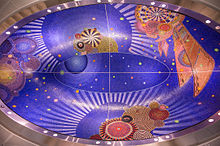Xenobia Bailey

Xenobia Bailey (born 1955, in Seattle, Washington) is an American artist and designer best known for her eclectic crochet hats[1] and her large scale crochet pieces and mandalas, consisting of colorful concentric circles and repeating patterns. Her pieces are often connected to her ongoing project "Paradise Under Reconstruction in the Aesthetic of Funk".[2]
Her designs are influenced by African, Chinese, and Native American and Eastern philosophies, with undertones of the 1970s "Funk" aesthetic. Her hats have been featured in United Colors of Benetton ads, on The Cosby Show, and in the Spike Lee film Do The Right Thing[3] (worn by Samuel L. Jackson as DJ Mister Señor Love Daddy). In 2003, her designs were commemorated in the form of an Absolut Vodka Ad entitled "Absolut Bailey."[4] Bailey has been artist-in-residence at the Studio Museum in Harlem, the Society for Contemporary Craft in Pittsburgh, and the Marie Walsh Sharpe Art Foundation in New York City. Her work has been exhibited at the Studio Museum of Harlem,[5] the Jersey City Museum, the New Museum of Contemporary Art, and the High Museum of Art in Atlanta. Her work is in the permanent collections at Harlem's Schomburg Center for Research in Black Culture, the Allentown Art Museum, and the Museum of Contemporary Arts and in the Museum of Arts and Design.[6] Some of her crochet work was transformed into mosaics for the New York City Subway's 34th Street – Hudson Yards station.[7]
Early life and education
Xenobia Bailey studied ethnomusicology at the University of Washington, it was there that her interest in craftsmanship and fabric took full bloom. She worked as a costume designer for the renowned African-American community theater, Black Arts West, until her acceptance into Pratt Institute in Brooklyn in 1974. She received her BA in industrial design while she learned to crochet under needle artist, Bernadette Sonona, after which she began to create and sell colorful crocheted hats inspired by distinctly African-American patterns, themes, and hairstyles.[8]
References
- ^ "Style Makers; Xenobia Bailey, African-Hat Designer". The New York Times. August 19, 1990. Retrieved 27 January 2013.
- ^ Museum, Brooklyn. "Mothership 1: Sistah Paradise's Great Walls of Fire Revival Tent". Brooklyn Museum. Retrieved 27 January 2013.
- ^ Otfinoski, Steven (2011). African Americans in the Visual Arts. Facts On File, Incorporated. pp. 9, 10. ISBN 9780816078400.
- ^ Farrington. E., Lisa (2004). Creating Their Own Image: The History of African-American Women Artists. Oxford University Press, USA. pp. 253, 254. ISBN 019516721X.
- ^ "The Bearden Project". The Studio Museum in Harlem. Retrieved 27 January 2013.
- ^ Bailey, Xenobia. "Museum of Arts and Design Permanent Collection". Museum of Arts and Design. Retrieved 27 January 2013.
- ^ Metropolitan Transportation Authority. "7 Line Extension". Retrieved 14 September 2015.
- ^ "U.S. Department of State Artist Profile". U.S. Department of State. Retrieved 20 January 2013.
- African-American artists
- American costume designers
- American fashion designers
- American women installation artists
- Dollmakers
- Milliners
- 20th-century women artists
- 21st-century women artists
- 1955 births
- Living people
- Artists from Seattle, Washington
- Pratt Institute alumni
- University of Washington alumni
- 20th-century American artists
- 21st-century American artists
